Physical Address
304 North Cardinal St.
Dorchester Center, MA 02124
While it is implanting into the uterine wall, the embryo undergoes profound changes in its organization. Until the time of implantation, the blastocyst consists of the inner cell mass, from which the body of the embryo proper arises, and the outer trophoblast, which represents the future tissue interface between the embryo and mother. Both components of the blastocyst serve as the precursors of other tissues that appear in subsequent stages of development. Chapter 4 discusses how the cytotrophoblast gives rise to an outer syncytial layer, the syncytiotrophoblast, shortly before attaching to uterine tissue (see Figure 4.20 ). Not long after, the inner cell mass begins to give rise to other tissue derivatives as well. The subdivision of the inner cell mass ultimately results in an embryonic body that contains the three primary embryonic germ layers: the ectoderm (outer layer), mesoderm (middle layer), and endoderm (inner layer). The process by which the germ layers are formed through cell movements is called gastrulation .
After the germ layers have been laid down, the continued progression of embryonic development depends on a series of signals called embryonic inductions , which are exchanged between the germ layers or other tissue precursors. In an inductive interaction, one tissue (the inductor ) acts on another ( responding tissue ) so that the developmental course of the latter is different from what it would have been in the absence of the inductor. The developments that can be seen with a microscope during this period are tangible reflections of profound changes in gene expression and cellular properties of implanting embryos.
While the embryo is preparing to undergo implantation late in the first week, another major developmental event is occurring in the inner cell mass. Initially homogeneous, the cells of the inner cell mass diverge into two distinct lineages: those that will form the hypoblast , or primitive endoderm —a lineage of extraembryonic cells—and those that will form the epiblast —a lineage producing mainly cells of the embryo itself ( Figure 5.1 , see Figure 4.20 ). The cells of the hypoblast take on characteristics of epithelial cells soon after their formation and form a single thin layer immediately below the epiblast ( Figure 5.2B ). The cells of the epiblast are then also rearranged into an epithelial configuration, which is sometimes referred to as the embryonic shield .
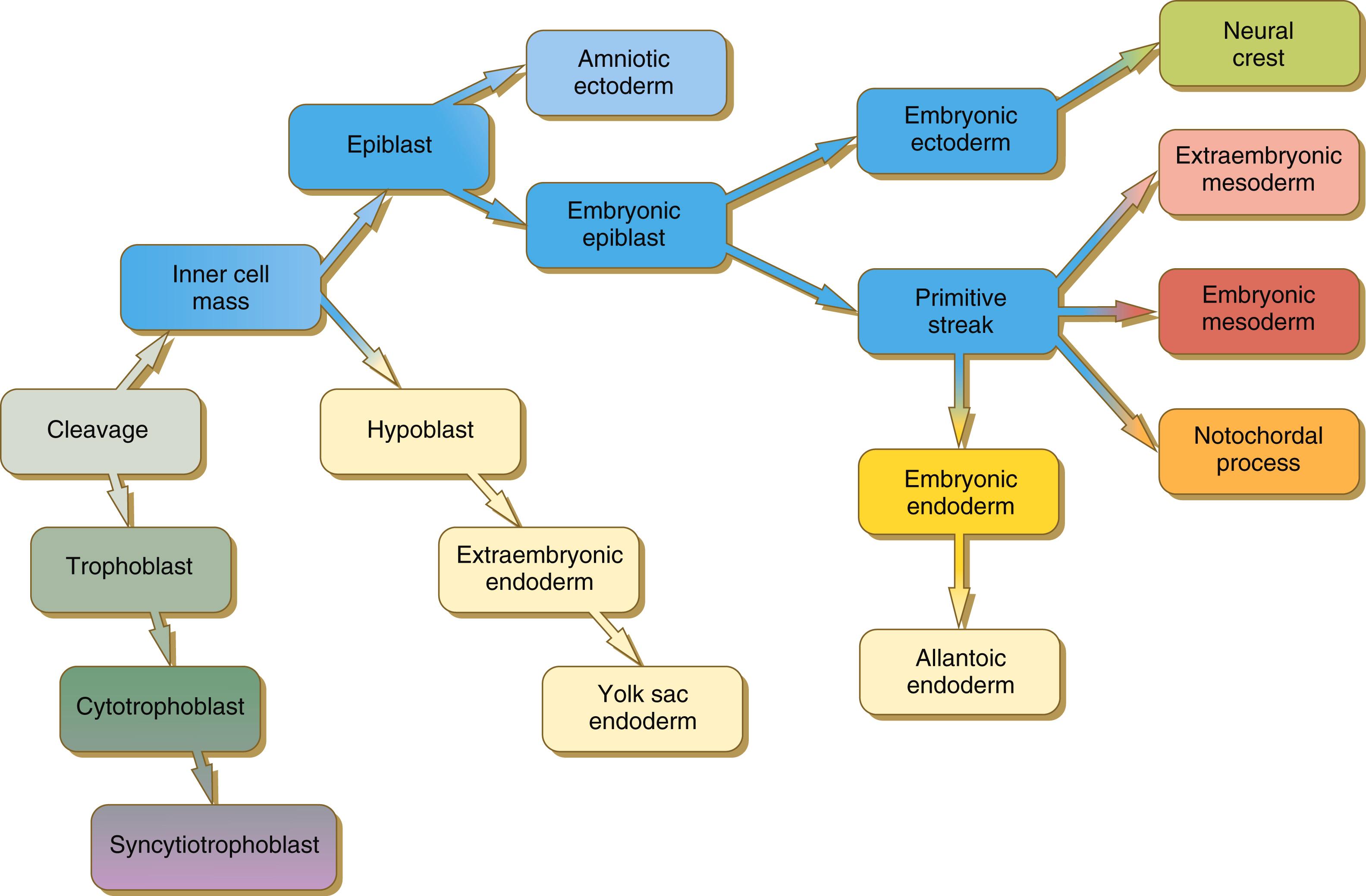
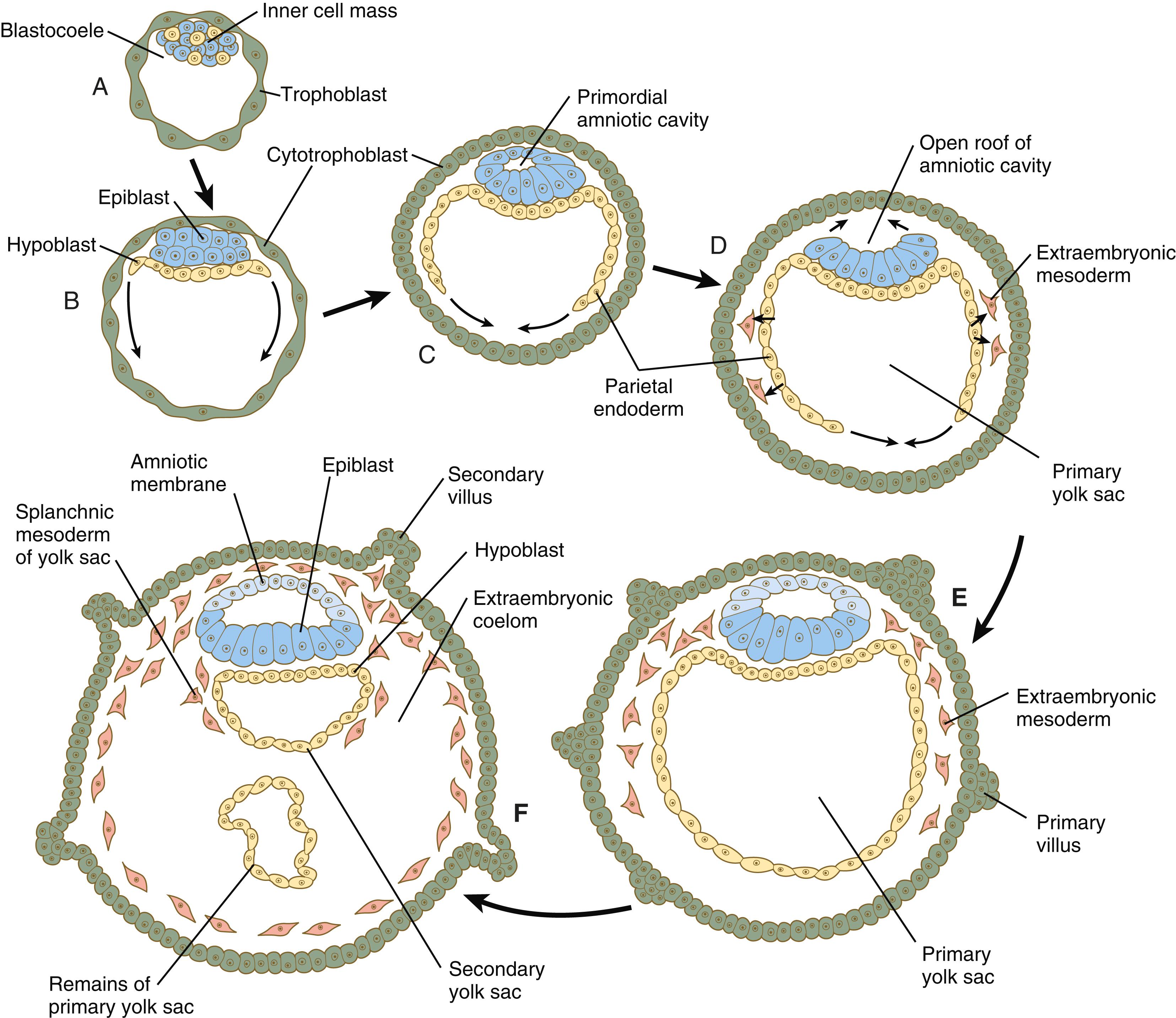
How the hypoblast forms in human embryos is not understood, but studies on mouse embryos have shown that as early as the 64-cell stage, some cells of the inner cell mass express the transcription factor nanog , whereas others express Gata 6 . These cells are arranged in a salt and pepper pattern within the inner cell mass ( Figure 5.3 ). The nanog-expressing cells represent the precursors of the epiblast, and those expressing Gata 6 will become the hypoblast. The basis for the differentiation of these two distinct precursor cell types is not completely understood, but according to the “time inside–time outside” hypothesis, those cells that enter the inner cell mass earliest are biased to express nanog, which perpetuates their pluripotency. Because of the influence of fibroblast growth factor-4 (FGF-4), secreted by these first arrivals to the inner cell mass, later immigrants are then biased to express Gata 6. The Gata 6-expressing cells produce molecules that increase their adhesive properties and their mobility, and they make their way to the lower surface of the inner cell mass to form a thin epithelium, the hypoblast. Those Gata 6 cells that fail to reach the surface of the inner cell mass undergo apoptosis (cell death). The nanog-expressing cells of the inner cell mass also assume an epithelial configuration as they form the epiblast. Between the epiblast and hypoblast a basal lamina forms.
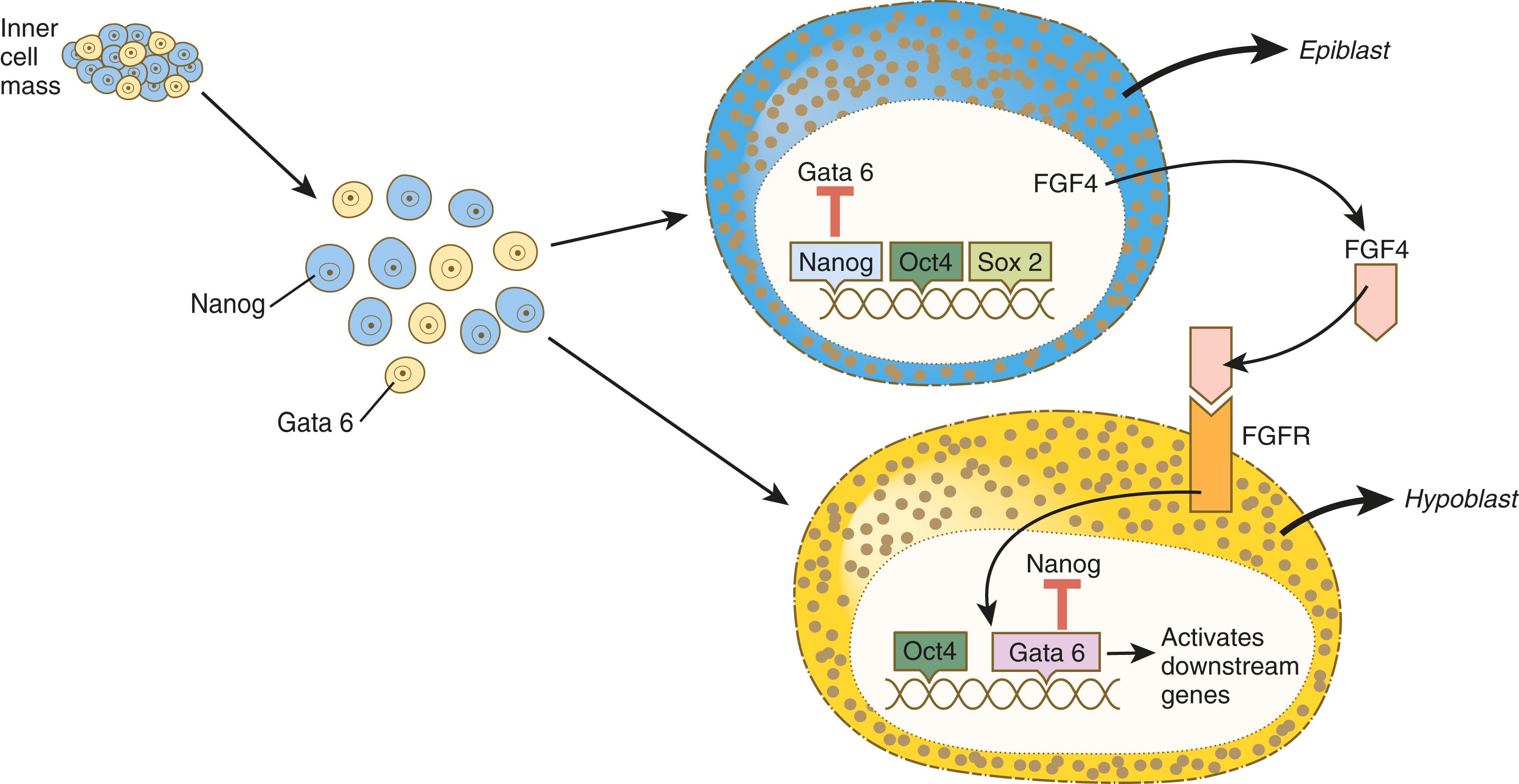
A small group of hypoblast cells that becomes translocated to the future anterior end of the embryo (called anterior visceral endoderm by mouse embryologists) has been shown to possess remarkable signaling powers. The cells first secrete the signaling molecules, Lefty-1 and Cerberus-1 (Cer-1) , which inhibit the activity of the signaling molecules, Nodal and Wnt , in the overlying epiblast but allow nodal and Wnt-3 expression in the posterior epiblast (see Figure 5.10A ). (Nodal signaling from the posterior epiblast stimulates the initial formation of the anterior visceral endoderm.) This represents the first clear expression of anteroposterior polarity in the embryo. It also forms two signaling domains within the early embryo. The anterior visceral endoderm prevents formation of the primitive streak (see the next section) in the anterior part of the epiblast. Through the local inhibition of nodal and Wnt by the actions of Lefty-1 and Cerberus-1, the anterior visceral endoderm suppresses the development of posterior structures in the anterior part of the embryo and is heavily involved in organizing the early development of the forebrain and head. In the posterior part of the epiblast, nodal signaling activity stimulates the formation of the primitive streak, which is the focal point for gastrulation and germ layer formation. After the hypoblast has become a well-defined layer and the epiblast has taken on an epithelial configuration, the former inner cell mass is transformed into a bilaminar disk , with the epiblast on the dorsal surface and the hypoblast on the ventral surface.
The epiblast contains the cells that make up the embryo itself, but extraembryonic tissues also arise from this layer. The next layer to appear after the hypoblast is the amnion , a layer of extraembryonic ectoderm that ultimately encloses the entire embryo in a fluid-filled chamber called the amniotic cavity (see Chapter 7 ). Because of the paucity of specimens, the earliest stages in the formation of the human amnion and amniotic cavity are not completely understood. Studies on primate embryos indicate that a primordial amniotic cavity first arises by cavitation (formation of an internal space) within the preepithelial epiblast; it is covered by cells derived from the inner cell mass (see Figure 5.2 ). According to some investigators, the roof of the amnion then opens, thus exposing the primordial amniotic cavity to the overlying cytotrophoblast. Soon thereafter (by approximately 8 days after fertilization), the original amniotic epithelium reforms a solid roof over the amniotic cavity.
While the early embryo is still sinking into the endometrium (approximately 9 days after fertilization), cells of the hypoblast begin to spread and line the inner surface of the cytotrophoblast with a continuous layer of extraembryonic endoderm called parietal endoderm ( Figure 5.4 ; see Figure 5.2 ). When the endodermal spreading is completed, a vesicle called the primary yolk sac has taken shape (see Figure 4.20C ). At this point (about 10 days after fertilization), the embryo complex constitutes the bilaminar germ disk, which is located between the primary yolk sac on its ventral surface and the amniotic cavity on its dorsal surface ( Figure 5.5 ). Shortly after it forms, the primary yolk sac becomes constricted, forming a secondary yolk sac and leaving behind a remnant of the primary yolk sac (see Figures 4.20D and 5.2F ).
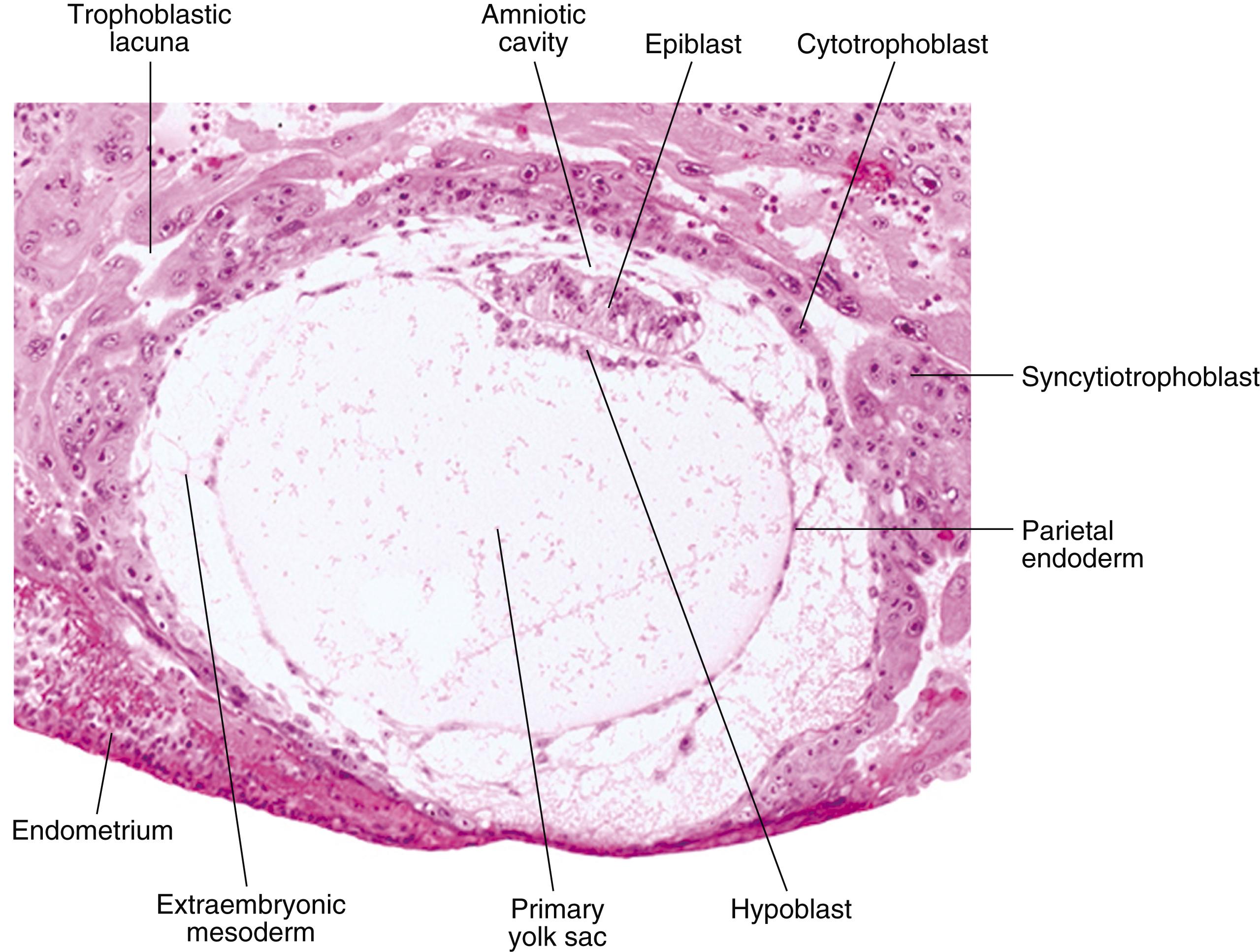
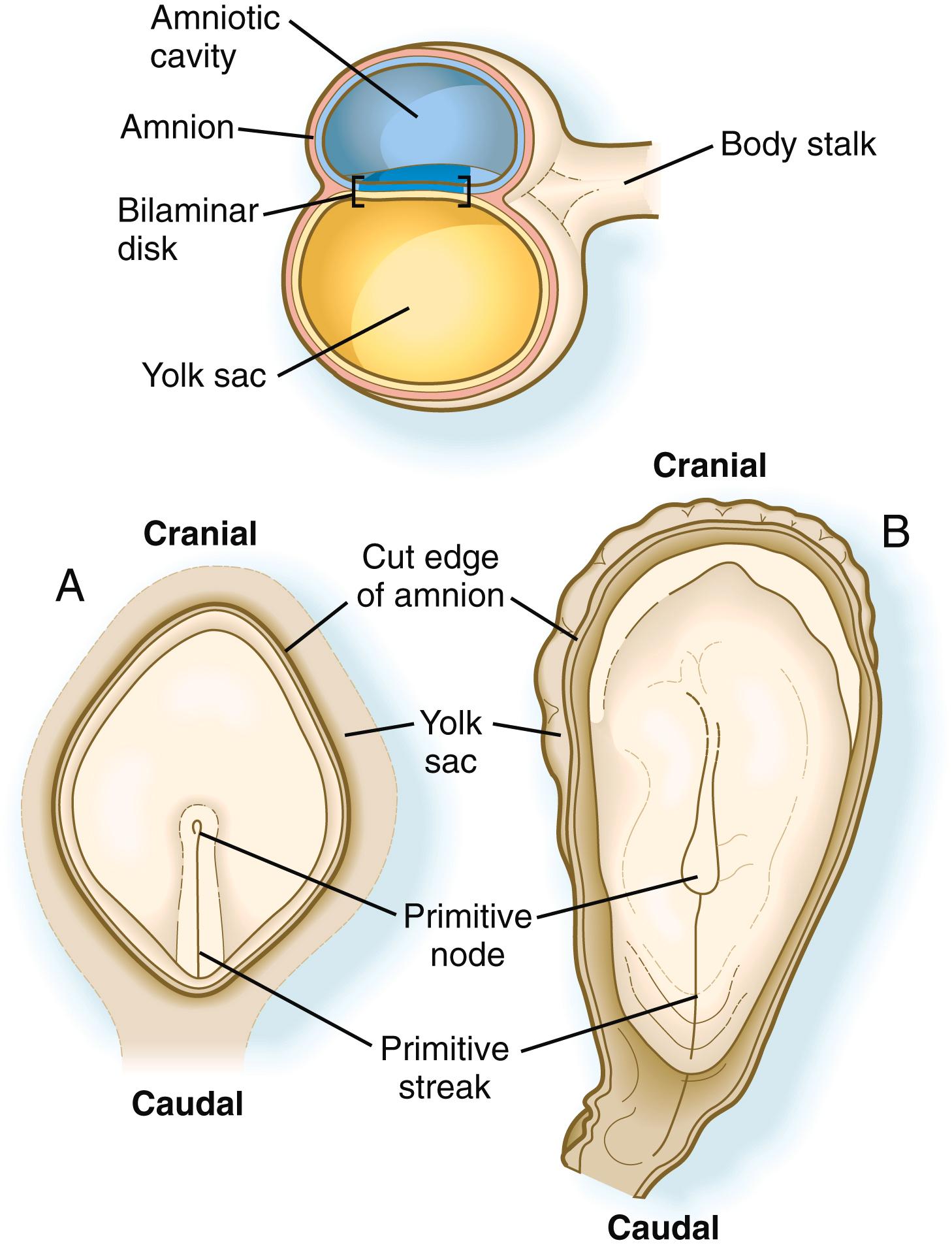
Starting at about 12 days after fertilization, another extraembryonic tissue, the extraembryonic mesoderm , begins to appear (see Figure 5.2 ). The first extraembryonic mesodermal cells seem to arise from a transformation of parietal endodermal cells. These cells are later joined by extraembryonic mesodermal cells that have originated from the primitive streak. The extraembryonic mesoderm becomes the tissue that supports the epithelium of the amnion and yolk sac and the chorionic villi , which arise from the trophoblastic tissues (see Chapter 7 ). The support supplied by the extraembryonic mesoderm is not only mechanical but also trophic because the mesoderm serves as the substrate through which the blood vessels supply oxygen and nutrients to the various epithelia.
At the end of the second week, the embryo consists of two flat layers of cells: the epiblast and the hypoblast. As the third week of pregnancy begins, the embryo enters the period of gastrulation, during which the three embryonic germ layers form from the epiblast (see Figure 5.1 ). The morphology of human gastrulation follows the pattern seen in birds. Because of the large amount of yolk in birds’ eggs, the avian embryo forms the primary germ layers as three overlapping flat disks that rest on the yolk, similar to a stack of pancakes. Only later do the germ layers fold to form a cylindrical body. Although the mammalian egg is essentially devoid of yolk, the morphological conservatism of early development still constrains the human embryo to follow a pattern of gastrulation similar to that seen in reptiles and birds. Because of the scarcity of material, even the morphology of gastrulation in human embryos is not known in detail. Nevertheless, extrapolation from avian and mammalian gastrulation can provide a reasonable working model of human gastrulation.
Gastrulation begins with the formation of the primitive streak , a linear midline condensation of cells derived from the epiblast in the posterior region of the embryo through an induction by cells at the edge of the embryonic disk in that region (see Figure 5.5 ). Nodal and Wnt3 have been identified as agents that induce the primitive streak. Initially triangular, the primitive streak soon becomes linear and elongates, largely through a combination of proliferation, migration, and internal cellular rearrangements called convergent-extension movements , which involve the movement of lateral cells toward the midline, their intercalation with existing midline cells, and then their elongation along the anteroposterior axis. Critical to the anterior extension of the cells of the primitive streak is the T-box transcription factor Eomes , a target of nodal. If Eomes is blocked, the cells are induced and express the usual markers of the primitive streak, but they pile up at the posterior end of the embryo. With the appearance of the primitive streak, the anteroposterior (craniocaudal) and right–left axes of the embryo can be readily identified.
The primitive streak is a region where cells of the epiblast converge in a well-defined spatial and temporal sequence. As cells of the epiblast reach the primitive streak, they change shape (an example of an epithelial-mesenchymal transition; see p. 79) and pass through it on their way to forming new layers beneath (ventral to) the epiblast ( Figure 5.6C ).
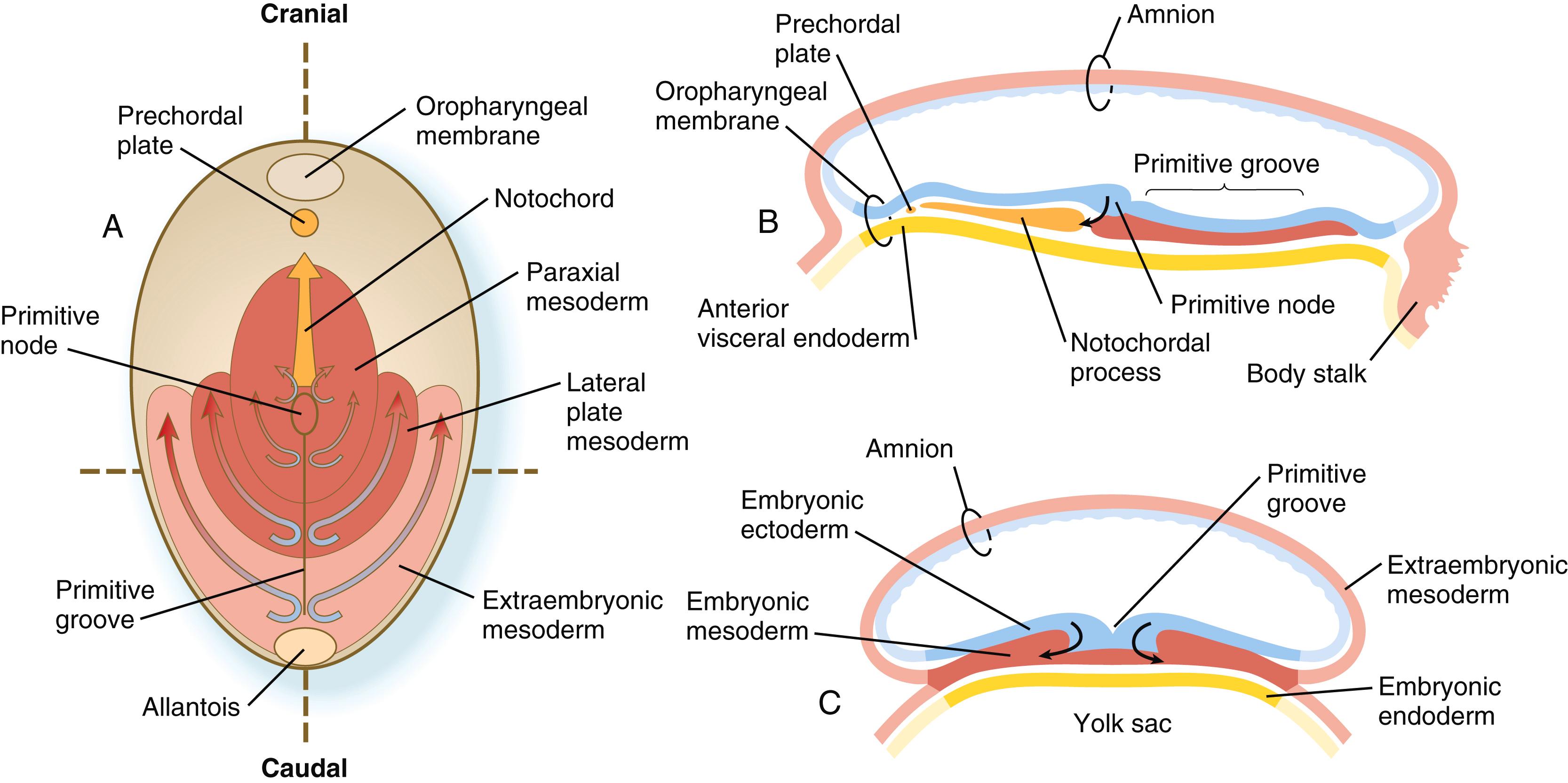
Marking studies have shown that cells entering the primitive streak form distinct lineages while they leave. The most posterior cells both to enter and to leave the streak as it is beginning to elongate form the extraembryonic mesoderm lining the trophoblast and yolk sac and that forming the blood islands (see Figure 6.24 ). Another wave of mesoderm, induced by Nodal, Wnt, and BMP and arising later and more anteriorly in the primitive streak, forms the paraxial, lateral plate , and cardiac mesoderm . These mesodermal cells are characterized by the expression of brachyury (T). A final wave, which enters and leaves the anteriormost end of the primitive streak, gives rise to midline axial structures (the notochord , the prechordal plate, and the primitive node itself) and also the embryonic endoderm , which is characterized by the expression of Foxa2. The composite results of such marking experiments are organized into fate maps , such as that illustrated in Figure 5.6A .
The endodermal precursor cells that pass through the anterior primitive streak largely displace the original hypoblast, but some of the original hypoblastic cells are integrated into the newly forming embryonic endodermal layer. The expression of SOX-17 is required for formation and migration of definitive endodermal cells. The cells that form the embryonic endodermal layer have undergone two major morphological transformations—from epithelial cells of the epiblast to mesenchyme while they pass through the primitive streak and then from primitive streak mesenchyme back to the epithelial configuration of the endoderm. Meanwhile, the displaced hypoblastic cells go on to form extraembryonic endoderm. The movement of cells through the primitive streak results in the formation of a groove ( primitive groove ) along the midline of the primitive streak. At the anterior end of the primitive streak is a small but well-defined accumulation of cells, called primitive node , or Hensen’s node . ∗
∗ Hensen’s node is the commonly used designation for the primitive node in avian embryos, but this term is occasionally used in the mammalian embryological literature as well. This structure is the structural and functional equivalent of the dorsal lip of the blastopore in amphibians.
This structure is of great developmental significance because, in addition to being a major signaling center of the embryo ( Box 5.1 ), it is the area through which cells migrate in a stream toward the anterior end of the embryo. These cells, called mesendoderm , soon segregate into a rodlike mesodermal notochord and the endodermal dorsal wall of the forming gut. Anterior to the notochord is a group of mesodermal cells called the prechordal plate (see Figure 5.6A and B ). (The important functions of the notochord and prechordal plate are discussed on p. 80.)
Many decades of research on birds and amphibians have resulted in a reasonable understanding of the cellular and molecular aspects of gastrulation in these species. More recent research suggests that despite some species differences, the basic aspects of gastrulation in mammals are fundamentally similar to those in birds.
The events of gastrulation are guided by a series of molecular inductions emanating from a succession of signaling centers, starting with the anterior visceral endoderm and progressing to the future caudal (posterior) part of the embryo. Early posterior signaling results in the formation of the primitive streak and the induction of mesoderm. When the primitive streak is established, the primitive node takes over as the center that organizes the fundamental structure of the body axis. As the notochord takes shape from cells that flow through the primitive node, it becomes an important signaling center. In humans, the role of the cells of the prechordal plate is not well understood. In birds, the prechordal plate acts as an anterior signaling center, similar to the anterior visceral endoderm in mice. Whether anterior signaling in humans is confined to anterior hypoblast (anterior visceral endoderm) or the prechordal plate, or both, remains to be determined.
For this aspect of early development, we must rely almost entirely on studies of mouse embryos. The original symmetry of the embryo is broken by the displacement of the future anterior visceral endoderm to the anterior side of the embryonic disk. This is a function of proliferation and later migration of the cells that will constitute the anterior visceral endoderm. Migration of these cells (and the resulting establishment of the anteroposterior axis) depends on the activation of the Wnt antagonist Dkk 1 (Dickkopf 1) in the future anterior part of the embryo. This confines Wnt activity to the future posterior part of the embryo, where it induces the expression of the signaling molecule Nodal ( Figure 5.10A ). When the anterior visceral endoderm has stabilized in the anterior part of the embryonic disk, it produces the Nodal inhibitors Lefty-1 and Cer-1 , which confine Nodal activity to the posterior end of the embryo where, responding to extraembryonic Wnt signals, it establishes a posterior signaling center, which induces the formation of the primitive streak, the definitive endoderm, and the mesoderm.
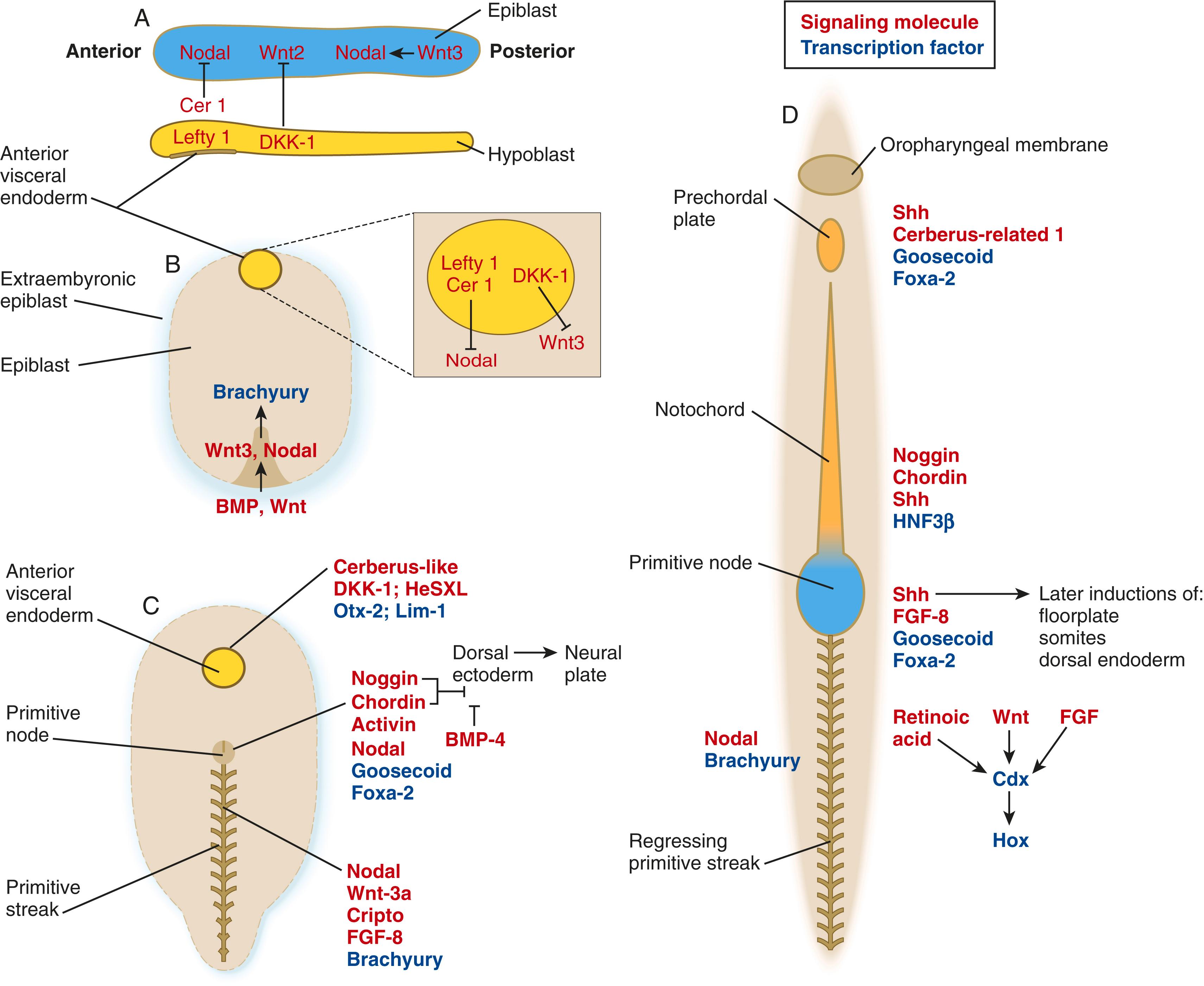
As the primitive streak elongates, migrating cells of the epiblast join the tip of the streak, and a dynamic mass of cells, called the primitive node , becomes evident at the tip of the primitive streak. Formation of the primitive node depends upon BMP-4 activating the Wnt pathway, which then activates the activin-Nodal pathway. Cells of the node express many genes, including three classic molecular markers of the organizer region in many vertebrates— Chordin, Goosecoid , and Foxa-2 . Not only is the winged helix transcription factor, Foxa-2, important for the formation of the node itself, but it is also vital for the establishment of midline structures cranial to the node. Foxa-2 is required for the initiation of notochord function. In its absence, the notochord and the floor plate of the neural tube (see Chapter 11 ) fail to form. In contrast, endoderm, the primitive streak, and intermediate mesoderm do develop. Goosecoid , a homeodomain transcription factor, is prominently expressed in the organizer region of all vertebrates studied. Goosecoid activates Chordin, Noggin, and other genes of the organizer region. If ectopically expressed, it stimulates the formation of a secondary body axis. Chordin and Noggin , signaling molecules associated with the node, are involved with neural induction, and expression of Nodal on the left side of the embryo is a key element in the setting of left–right asymmetry.
Two genes, T and Nodal, play prominent roles in the function of the primitive streak and posterior mesoderm formation. Expression of the T gene (Brachyury) seems to be activated by products of the Foxa-2 and Goosecoid genes. In T mutants, the notochord begins to form through the activity of Foxa-2, but it fails to complete development. Studies on T mutants have shown that activity of the Brachyury gene is necessary for normal movements of future mesodermal cells through the primitive streak during gastrulation. In Brachyury (short tail) mutant mice, mesodermal cells pile up at a poorly formed primitive streak, and the embryos show defective elongation of the body axis (including a short tail) posterior to the forelimbs. T gene mutants may be responsible for certain gross caudal body defects in humans. Nodal , a member of the transforming growth factor-β (TGF-β) family of growth factor genes (see Table 3.1 ), is expressed throughout the posterior epiblast before gastrulation, but its activity is concentrated at the primitive node during gastrulation. Similar to the Brachyury gene, the effects of Nodal are strongly seen in the caudal region of the embryo. In the null mutant of Nodal, the primitive streak fails to form, and the embryo is deficient in mesoderm. Similarly, mutants of Cripto, an early-acting member of the epidermal growth factor family and an essential cofactor in the Nodal signaling pathway, produce a trunkless phenotype. Another important function of the node and nodal is the establishment of left–right asymmetry ( Box 5.2 ).
While cells pass through the primitive streak, a region of Hox gene expression begins to form around the streak. The pattern of Hox gene expression in the future trunk and posterior part of the embryo is based on signaling by three molecules—retinoic acid, Wnt, and FGF—that act on the transcription factor Cdx (the mammalian equivalent of caudal in Drosophila ) in the area of the regressing primitive streak just behind the last-forming somites (see Fig. 6.6 ). Cdx acts on the Hox genes, which impose unique characteristics to the segmental structures that form along the anteroposterior axis of the embryo ( Figure 5.10D ).
The first cells passing through the primitive node form a discrete midline mass of cells, the prechordal plate, which is closely associated with endoderm in the region just caudal to the oropharyngeal membrane. The next generation of cells passing through the node forms the notochord.
The notochord is a major axial signaling center of the trunk in the early embryo, and it is important in the formation of many axial structures. Under the influence of Foxa-2 and Goosecoid, cells of the forming notochord produce Noggin and Chordin, molecules known to be potent neural inducers in many species. The notochord also produces sonic hedgehog (shh), the effector molecule for many notochordal inductions of axial structures after the neural plate is induced. Despite inducing the neural plate within the overlying ectoderm, however, the notochord does not stimulate the formation of anterior parts of the brain or head structures. This function is reserved for the anterior visceral endoderm.
The prechordal plate , sometimes called the head organizer , consists of early mesendodermal cells passing through the primitive node. These cells are structurally and functionally closely associated with cells of the underlying anterior endoderm. Along with anterior visceral endoderm (see below), the prechordal plate is the source of important signals, especially shh, that are involved in ventral patterning of the forebrain. In addition, the prechordal plate is the source of signals that are important for the survival of neural crest cells that emigrate from the early forebrain.
Become a Clinical Tree membership for Full access and enjoy Unlimited articles
If you are a member. Log in here